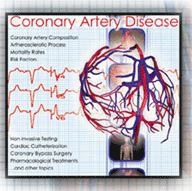 CAD takes you
visually from normal circulation and normal arteries, through the
atherosclerotic process and its prevention, defines risk factors, outlines
ischemic syndromes and their treatment protocols, provides a definitive
non-invasive testing section with interpretation methodology, describes Angina
management, has an in-depth section on pharmacological management, provides a
clear understanding and visual of catheterization, and takes you into the
operating theatre to observe the bypass surgery. It is unique in its
inclusiveness and clear instruction.
CAD takes you
visually from normal circulation and normal arteries, through the
atherosclerotic process and its prevention, defines risk factors, outlines
ischemic syndromes and their treatment protocols, provides a definitive
non-invasive testing section with interpretation methodology, describes Angina
management, has an in-depth section on pharmacological management, provides a
clear understanding and visual of catheterization, and takes you into the
operating theatre to observe the bypass surgery. It is unique in its
inclusiveness and clear instruction. Educational Objectives
Upon completion of the CD, the learner will be able to:
· Accurately diagram and describe coronary circulation, identifying the process, structures, and potential for disease
· Define the significance of specific coronary structures and their purpose.
· Identify coronary tissue types and cells from slides and describe their function.
· Describe and define the cellular events process which results in atherosclerosis.
· Accurately assess the statistical danger to the world population from Coronary Artery Disease (CAD)
· Identify all risk factors involved in CAD and define treatment protocols.
· Accurately describe the levels of the diagnostic process for CAD, the information available at each level, and the reasons for choosing or avoiding each type.
· Describe medical management of chronic stable angina, identification and treatment of associated diseases, and the process of reduction of coronary risk factors.
· Identify types of drugs used for CAD and match these with specific associated physiological indicators of disease.
· Describe the goal of coronary interventions.
· Outline and describe indications, procedure, risks and benefits of Coronary Artery Bypass Surgery.